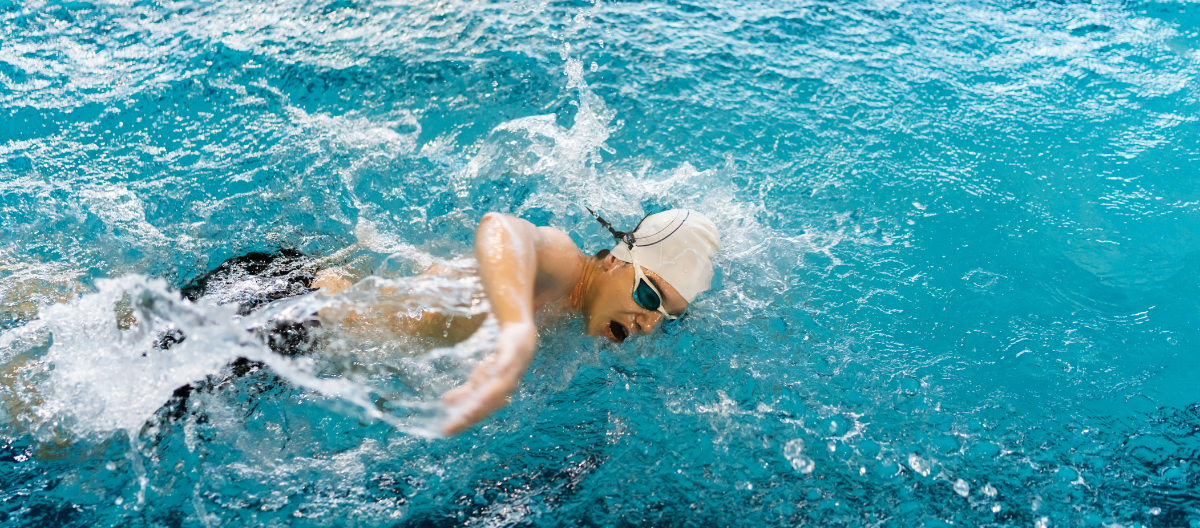Swimming is a full-body workout that offers numerous health benefits, including cardiovascular fitness, muscle strength, and flexibility. Mastering various swimming techniques can enhance your efficiency in the water, improve your endurance, and make swimming a more enjoyable experience. Here’s a comprehensive guide to the fundamental swimming techniques and tips for each stroke:
Freestyle -Front Crawl
Freestyle, also known as front crawl, is the fastest and most commonly used stroke in competitive swimming. To perform freestyle:
Keep your body flat and horizontal, with your head in line with your spine and your face in the water.
Alternate your arm strokes by extending one arm forward while the other arm recovers above the water. Your hands should enter the water thumb-first and follow a slight S-shaped path.
Turn your head to the side to breathe, coordinating with your arm movements. Breathe in quickly through your mouth and exhale through your nose while your face is in the water.
Use a flutter kick with your legs straight and slightly bent at the knees. Keep your feet close to the water’s surface and kick from your hips.
Maintain a steady rhythm and ensure your strokes are smooth and continuous. Practice bilateral breathing (breathing on both sides) to balance your stroke.
Backstroke
Backstroke is the only stroke performed on the back and is characterized by a smooth, flowing motion. To master backstroke:
Float on your back with your body in a horizontal position. Keep your head still, with your face looking up and ears in the water.
Alternate your arm strokes, keeping your arms straight and fully extended as they move through the water. Enter the water pinky-first and pull through in a circular motion.
Since your face is out of the water, you can breathe freely without altering your stroke.
Use a flutter kick similar to freestyle, with legs straight and slightly bent at the knees. The kick should be continuous and steady.
Keep your hips and chest up to maintain a streamlined position. Focus on a steady kick and avoid excessive head movement.
Breaststroke
Breaststroke is known for its distinctive arm and leg movements and is considered one of the more challenging strokes. To swim breaststroke:
Maintain a horizontal position with your head slightly above the water. Keep your body streamlined and your legs close to the surface.
Both arms move simultaneously in a half-circle motion. Start with your hands extended in front of you, pull them outward and then inward, and return them to the starting position.
Lift your head out of the water to breathe, coordinating with your arm pull. Inhale quickly through your mouth and exhale through your nose.
Perform a frog kick by bending your knees and bringing your feet towards your buttocks. Extend your legs outward and then back together in a circular motion.
Focus on smooth and rhythmic arm pulls and kicks. Maintain a steady pace and avoid excessive lifting of the head.
Butterfly Stroke
Butterfly stroke is known for its powerful and challenging movement. To master butterfly:
Keep your body flat and close to the water’s surface. Your head should be in line with your spine, and your gaze should be slightly forward.
Both arms move simultaneously in a windmill-like motion. Sweep your arms forward and outward, then pull them through the water and recover above the surface.
Breathe by lifting your head and shoulders out of the water during the arm recovery phase. Exhale quickly while your face is in the water.
Use a dolphin kick with both legs together, kicking from the hips and keeping your legs straight. The kick should be rhythmic and powerful.
Coordinate your arm and leg movements to maintain a smooth, flowing stroke. Practice the timing of your breath to match the rhythm of your stroke.
Sidestroke
Sidestroke is a more relaxed stroke often used for leisure swimming and endurance. To perform sidestroke:
Lie on your side with your head slightly tilted upward. Keep your body in a straight line, with your legs extended and slightly apart.
Use a scissor-like motion with your arms. One arm extends forward while the other arm is by your side, then alternate by pulling and recovering.
Breathe freely by lifting your head out of the water or turning it to the side.
Perform a scissor kick with your legs by alternating them in a wide, sweeping motion. Keep your legs straight but not rigid.
Focus on a smooth, steady rhythm and maintain a streamlined position to reduce drag.
General Tips for All Swimming Strokes
- Warm-Up and Cool Down: Always start with a warm-up to prepare your muscles and end with a cool-down to promote recovery.
- Practice Technique: Regularly practice each stroke to improve technique and efficiency. Consider working with a coach or taking swimming lessons for personalized guidance.
- Hydration: Stay hydrated before and after swimming to support overall health and performance.
- Safety: Always swim in designated areas with lifeguards present, and be aware of your swimming environment to ensure safety.


